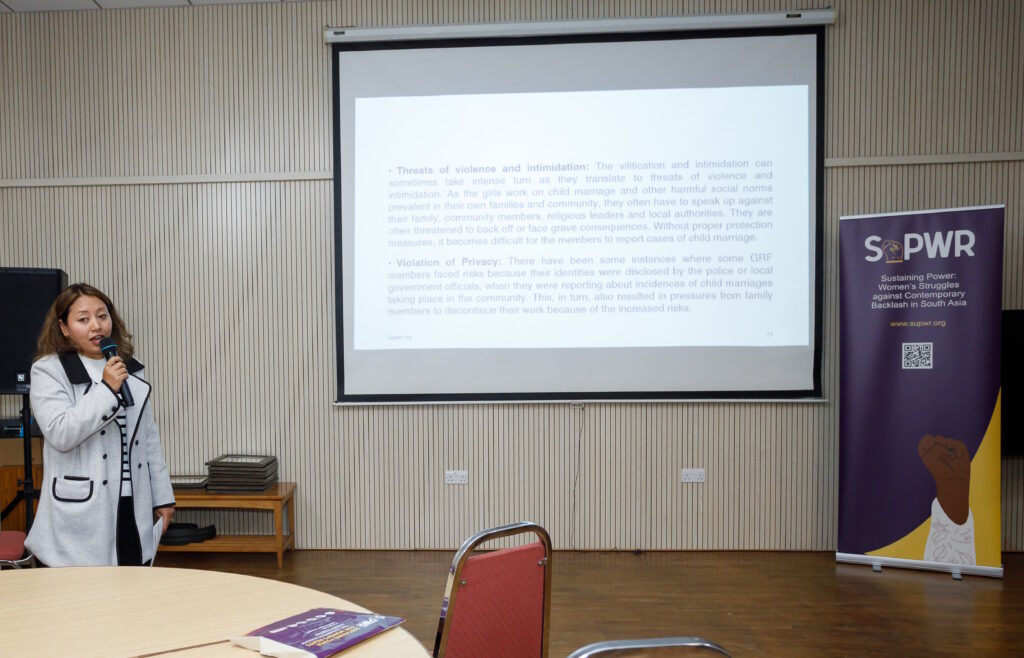In May 2025, the Islamabad Capital Territory (ICT) in Pakistan passed the Child Marriage Restraint Act, raising the legal age of marriage for girls to 18. This marks a major legal victory after years of organising by activists, researchers, and civil society groups. But this win did not come overnight—it is the outcome of decades of feminist resistance, legal advocacy, and research-backed policy efforts.
Research from the Institute of Development and Economic Alternatives (IDEAS) – a SuPWR partner – has helped illuminate the economic and social costs of child marriage, the political and judicial battlegrounds over legal reform, and the lived experiences of movement actors pushing for change.
Why There Should Be a Minimum Age: The Costing Study
In 2020, IDEAS conducted a costing study in collaboration with UN Women and the National Commission on the Status of Women (NCSW) to quantify the impact of child marriage in Pakistan.
Key findings:
- Early marriage leads to higher school dropout, lower labour participation, and poorer health outcomes.
- Adolescent girls face dangerous childbirths and limited decision-making power.
- Children born to young mothers are less healthy and less educated, perpetuating intergenerational poverty.
- One of the most unquantifiable yet devastating costs: a higher incidence of domestic violence.
SuPWR spotlight: Documenting resistance to child marriage
As part of the SuPWR project, IDEAS has been studying how women’s movements in Pakistan resist and re-strategise against backlash to achieve and sustain long-term gains. One key area of SuPWR’s focus is the struggle of civil society actors and organisations and their allies in state institutions against child marriage.
This 5-year longitudinal study on child marriage examines the struggle across three jurisdictions. In Islamabad and Punjab, it charts the lengthy contestation over legislative reform to enhance the minimum age of marriage for girls to 18, while in Sindh it follows the convoluted trajectory in the implementation of the child marriage restraint law that was passed back in 2013.
Using qualitative methods — including in-depth interviews, struggle diaries, focus group discussions, and theatre-based reflective workshops — the study engaged civil society actors and leaders working on the ground to change the discourse on child marriage and win allies in their quest for reform. Their stories show how grassroots advocacy, political coalition-building, and socio-legal strategy helped in sustaining power in the face of deep institutional and ideological backlash.
The passage of the Child Marriage Restraint Act 2025 in ICT raising the legal age of marriage for girls to 18 marks a high point in the countrywide struggle. This law is more than legislative reform — it is the outcome of a long, collective women’s struggle to sustain power in the face of systemic resistance.
Timeline of the struggle
From colonial laws to judicial victories and political momentum, here’s how the struggle evolved:
Digital archive on the struggle against child marriage in Pakistan
Curated by Khadija Tahir, our digital archive maps over a decade of grassroots advocacy, legal reform, and public debate.
SuPWR exhibition in Lahore
From December 16–18, 2024, IDEAS co-hosted the SuPWR Exhibition at the Lahore University of Management Sciences (LUMS) as part of the Pathways to Development Conference.
IDEAS documented the anti-child marriage campaign’s legal victories and grassroots mobilisation across ICT, Sindh, and Punjab. This case was displayed alongside other regional movements, creating space for reflection, learning, and cross-border solidarity.
View the full SuPWR Virtual Exhibition to explore all 16 struggles from across South Asia.
You can also watch testimonies from activists and researchers who attended the SuPWR exhibit and for a walkthrough of the full exhibit.
For more: Wakelet archive
For more information, you can explore our Anti-child marriage Wakelet archive on the anti-child marriage struggle webpage for legal judgments, news articles, and case material related to child marriage in Pakistan.
—
A version of this blog post was first published on the IDEAS website on June 5, 2025.


